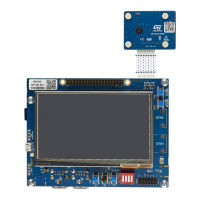
Do you have a question about the ST STM32MP135F-DK and is the answer not in the manual?
| Brand | ST |
|---|---|
| Model | STM32MP135F-DK |
| Category | Microcontrollers |
| Language | English |
Explains the meaning of the product codification system.
Lists the necessary hardware and software for development.
Recommends development tools like STM32CubeIDE and GCC-based IDEs.
Details the preloaded STM32 MPU OpenSTLinux Distribution.
Specifies the intended users and warns against use by children.
Provides precautions for handling the PCB and static-sensitive devices.
States that the product does not include a battery.
States that the product does not include a laser.
Details power supply requirements and compliance standards.
Illustrates the board's physical layout and component connections.
Details electrical configurations for Ethernet, VBAT, and STLINK-V3E.
Describes the integrated STLINK-V3E debugger/programmer.
Details the requirements for powering the kit via USB Type-C®.
Explains the voltage outputs from the STPMIC1 power management IC.
Specifies the 32.768 kHz crystal used for LSE clock reference.
Specifies the 24 MHz crystal used for HSE clock reference.
Explains how boot pins select the boot source at startup.
Provides an overview of the four USB Host ports and USB hub.
Details the I/O configuration for the USB Host interface.
Covers USB high-speed communication via USB Type-C® connector.
Specifies the operating voltage range for the USB Type-C® HS interface.
Explains the discovery kit's behavior as a USB Host when a device is connected.
Shows the pinout of the USB Type-C® connector (CN7).
Details the microSD card slot routed to the SDIO port.
Specifies the voltage range and supported modes for microSD™ cards.
Describes the I/O configuration for the SDIO interface for microSD™ cards.
Explains the function of various LEDs on the board (power, heartbeat, verdict).
States that LEDs operate in the 3.3 V voltage range.
Details the I/O configuration for the LED interfaces.
Describes the five buttons: USER1, USER2, Wake-up, Tamper, and Reset.
Details the I/O configuration for the physical user interface buttons.
Describes the camera module and CSI-DCMI bridge for image data deserialization.
Details the I/O configuration for the DCMI interface.
Details the CSI interface and pinout of the CN1 connector.
Covers Wi-Fi® 802.11b/g/n and Bluetooth® Low Energy V4.1 support.
Specifies the 3.3 V voltage range for the Wi-Fi®/BLE module.
Details the I/O configuration for the Wi-Fi® interface.
Details the I/O configuration for the Bluetooth® Low Energy interface.
Describes the TFT LCD module, touch panel, resolution, and colors.
Specifies power supply for the LCD module and backlight.
Details the I/O configuration for the LCD and CTP interfaces.
Explains the RMII interface, clocking, and Wake on LAN support for Ethernet.
Specifies the voltage for the Ethernet PHYs.
Discusses GPIO usage, alternate functions, and Raspberry Pi® shield compatibility.
Shows the pinout of the CN8 GPIO connector.
Explains the VBAT connector for maintaining critical operations during VDD power loss.
Specifies the external supply voltage range for the VBAT connector.
Details the I/O configuration of the CN11 VBAT interface.
Shows the pinout and function of the CN11 VBAT connector.
Describes product identification stickers on the PCB and their meaning.
Details the product's initial revision, MPU silicon, and board references.
Lists board references, variants, revisions, and limitations.
States compliance with FCC Part 15 rules and modification warnings.
Covers ISED Canada RF exposure limits and compliance with RSS standards.
Provides details on FCC ID, IC, license-exempt apparatus, and RF exposure.
Warns about Class A product compliance with EN55032/CISPR32 and potential interference.
States compliance with EU Directive 2014/53/EU for radio equipment.
